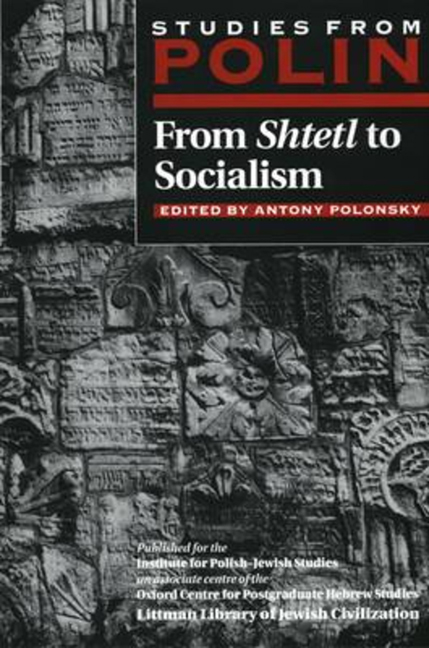Book contents
- Frontmatter
- Dedication
- Editors and Advisers
- Polin
- Polin: Studies in Polish Jewry
- Acknowledgements
- Contents
- List of Maps
- Introduction
- PART I PRE-PARTITION POLAND (to 1795)
- PART II THE NINETEENTH CENTURY
- PART III BETWEEN THE TWO WORLD WARS
- PART IV THE SECOND WORLD WAR
- PART V AFTER 1945
- 25 The Contexts of the So-Called Jewish Question in Poland after World War II
- 26 Is there a Jewish School of Polish Literature?
- 27 A Voice from the Diaspora: Julian Stryjkowski
- 28 Poles and Poland in I. B. Singer's Fiction
- Notes on Contributors
- Chronological Table
- Maps
- Glossary
- Index
25 - The Contexts of the So-Called Jewish Question in Poland after World War II
from PART V - AFTER 1945
- Frontmatter
- Dedication
- Editors and Advisers
- Polin
- Polin: Studies in Polish Jewry
- Acknowledgements
- Contents
- List of Maps
- Introduction
- PART I PRE-PARTITION POLAND (to 1795)
- PART II THE NINETEENTH CENTURY
- PART III BETWEEN THE TWO WORLD WARS
- PART IV THE SECOND WORLD WAR
- PART V AFTER 1945
- 25 The Contexts of the So-Called Jewish Question in Poland after World War II
- 26 Is there a Jewish School of Polish Literature?
- 27 A Voice from the Diaspora: Julian Stryjkowski
- 28 Poles and Poland in I. B. Singer's Fiction
- Notes on Contributors
- Chronological Table
- Maps
- Glossary
- Index
Summary
Any historian seeking a better insight into the nature and dynamics of Polish-Jewish relations after World War II, must force his way through areas which have been distorted for many years by two types of falsehood: lies of silence and lies of word and deed. Both have their causes - great fear and petty cowardice, deep defeatism and everyday opportunism, occasionally feelings of shame, but, all too frequently, purely tactical considerations. When the lie of silence persists too long and its failure to hide the truth becomes evident, the authorities try to prevent their further discrediting in world and national opinion, while the nation, even more sensitive to world opinion, strives also to drown out the voice of its conscience. At this point the silence is shattered. As this change does not usually stem from a love of the truth, but is rather an unwilling concession to avoid opprobium and condemnation, the areas passed over in silence are then deliberately filled with bogus models which project a mystified reality in order to mask the genuine situation. These facades are in fact half-truths based on conveniently selected facts, some unauthenticated and some genuine, manipulated to convey false messages. So that these constructs can perform their camouflaging function effectively, they are set within carefully chosen contexts which permit the clearly pejorative character of even universally condemned views and actions to be concealed, thus making them appear as elements of a higher order.
This mechanism, likely to be a universal one, has been widely applied in the game of appearances played in Poland over the last 40 years, and has allowed the masking of anti-semitism to gain dangerous popularity. Given the thorough discrediting of anti-semitism, negative attitudes towards Jews were forced to seek out contexts that could legitimize and even ennoble existing prejudices, antipathy, hostility, and discrimination. Consequently, cunning collages known to influence public opinion were created; in order to cloak the shameful nakedness of anti-semitism, they had to present themselves as apparently cleansed of racial criteria. Thus, both among the rulers and the ruled, the depiction of Jews exclusively as ‘emanations of Jewishness’ became, as it were, a taboo subject.
- Type
- Chapter
- Information
- From Shtetl to SocialismStudies from Polin, pp. 457 - 470Publisher: Liverpool University PressPrint publication year: 1993



